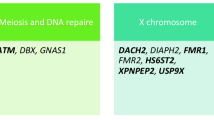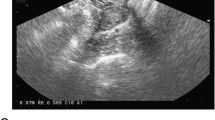Abstract
Premature ovarian insufficiency (POI) is defined as the cessation of ovarian function under the age of 40 years and is characterized by amenorrhea, hypoestrogenism, and elevated serum gonadotrophin concentration (FSH). It is a heterogeneous disorder with a multicausal pathogenesis; however, majority of cases are idiopathic. In idiopathic POI, involvement of unknown mechanisms may increase rate of oocyte apoptosis. Studies have shown that elevated reactive oxygen species (ROS) levels affect the quality of gametes. Mitochondrial mutations in different complexes of electron transport chain have been reported to disrupt the electron flow which lead to formation of more superoxide ions or increased levels of ROS. This study was aimed to screen the mitochondrial genome for variations in idiopathic POI (n = 25) and occult ovarian insufficiency (OI) (n = 5) patients. 30 patients diagnosed with POI and occult OI were enrolled in this study. Blood samples were collected from the patients and controls. DNA was extracted using phenol chloroform method. A total of 102 nucleotide variations were observed in patients as compared with 58 nucleotide variations in controls. 24% variations were found to be non-synonymous and 76% were synonymous. It was found that 48% variations were in complex I, 8% in complex III, 24% in complex IV, and 20% in complex V of electron transport chain. We found most of the non-synonymous mitochondrial variations in complex I (48%) of the respiratory chain which is the largest enzyme complex and is associated with oxidative stress. Some non-synonymous pathogenic alterations (p.M31T, p.W239C, p.L128Q) and non pathogenic alterations (ATPase6:p.T53I, ATPase6:p.L190F, ATPase6:p.L199L) were found to be significantly higher in cases as compared with controls. The preliminary data suggest that the mitochondrial mutations and subsequent decline in ATP levels may accelerate follicular atresia and lead to POI. The results of this preliminary study highlight the need to extend this study by analyzing large number of samples in different ethnic populations and analyze for ROS levels and mitochondrial mutations in oocytes as they are of different embryonic origin and develop in a different microenvironment.



Similar content being viewed by others
References
Coulam CB, Adamson SC, Annegers JF (1986) Incidence of premature ovarian insufficiency. Obstet Gynecol 67:604–606
Goswami D, Conway GS (2005) Premature ovarian failure. Hum Reprod Update 11(4):391–410
Venkatesh S, Kumar M, Sharma A, Kriplani A, Ammini AC, Talwar P, Agarwal A, Dada R (2010) Oxidative stress and ATPase6 mutation is associated with primary ovarian insufficiency. Arch Gynecol Obstet. doi:10.1007/s00404-010-1444-y
Coulam CB (1982) Premature gonadal failure. Fertil Steril 38(6):645–655
Hsueh AJ, Billig H, Tsafriri A (1994) Ovarian follicle atresia: a hormonally controlled apoptotic process. Endocr Rev 15(6):707–724
Hsueh AJ, Eisenhauer K, Chun SY, Hsu SY, Billig H (1996) Gonadal cell apoptosis. Recent Prog Horm Res 51:433–455
Morita Y, Tilly JL (1999) Oocyte apoptosis: like sand through an hourglass. Dev Biol 213:1–17
Agarwal A, Gupta S, Sharma RK (2005) Role of oxidative stress in female reproduction. Reprod Biol Endocrinol 3:28
Ames BN, Shigenaga MK, Hagen TM (1993) Oxidants, antioxidants, and the degenerative diseases of aging. Proc Natl Acad Sci USA 90:7915–7922
Shamsi MB, Venkatesh S, Tanwar M, Talwar P, Sharma RK, Dhawan A, Kumar R, Gupta NP, Malhotra N, Singh N, Mittal S, Dada R (2009) DNA integrity and semen quality in men with low seminal antioxidant levels. Mutat Res/Fundam Mol Mech Mutagen 665:29–36
Lu B, Christophe P, Tamas G, Christian G, Wilbur H, David B, Martin MM, Karl-Erik A, Paul AO, Colin EB (2008) A mutation in the inner mitochondrial membrane peptidase 2-like gene (Immp2l) affects mitochondrial function and impairs fertility in mice. Biol Reprod 78:601–610
Behrman HR, Kodaman PH, Preston SL, Gao S (2001) Oxidative stress and the ovary. J Soc Gynecol Investig 8:S40–S42
Agarwal A, Desai NR, Makker K, Varghese A, Mouradi R, Sabanegh E, Sharma R (2009) Effects of radiofrequency electromagnetic waves (RF-EMW) from cellular phones on human ejaculated semen: an in vitro pilot study. Fertil Steril 92(4):1318–1325
St John JC, Cooke ID, Barratt CL (1997) Mitochondrial mutations and male infertility. Nat Med 3:124–125
Madamanchi NR, Runge MS (2007) Mitochondrial dysfunction in atherosclerosis. Circ Res 100:460–473
Mancuso M, Coppede F, Migliore L, Siciliano G, Murri L (2006) Mitochondrial dysfunction, oxidative stress and neurodegeneration. J Alzheimer Dis 10:59–73
Sedensky MM, Morgan PG (2006) Mitochondrial respiration and reactive oxygen species in mitochondrial aging mutants. Exp Gerontol 41:237–245
Bedaiwy MA, Falcone T (2003) Peritoneal fluid environment in endometriosis: clinicopathological implications. Minerva Ginecol 55:333–345
Kumar M, Tanwar M, Saxena R, Sharma P, Dada R (2010) Identification of novel mitochondrial mutations in Leber’s hereditary optic neuropathy. Mol Vis 16:782–792
Sunyaev S, Ramensky V, Koch I, Lathe W 3rd, Kondrashov AS, Bork P (2001) Prediction of deleterious human alleles. Hum Mol Genet 10(6):591–597
Ramensky V, Bork P, Sunyaev S (2002) Human non-synonymous SNPs: server and survey. Nucleic Acids Res 30(17):3894–3900
Ng PC, Henikoff S (2003) SIFT: predicting amino acid changes that affect protein function. Nucleic Acids Res 31(13):3812–3814
Pagani F, Raponi M, Baralle FR (2005) Synonymous mutations in CFTR exon 12 affect splicing and are not neutral in evolution. PNAS 102:6368–6372
Carlini DB, Stephan W (2003) In vivo introduction of unpreferred synonymous codons into the Drosophila Adh gene results in reduced levels of ADH protein. Genetics 163(1):239–243
Carlini DB, Chen Y, Stephan W (2001) The relationship between third-codon position nucleotide content, codon bias, mRNA secondary structure and gene expression in the drosophilid alcohol dehydrogenase genes Adh and Adhr. Genetics 159(2):623–633
Parsch J, Braverman JM, Stephan W (2000) Comparative sequence analysis and patterns of covariation in RNA secondary structures. Genetics 154(2):909–921
van der Walt JM, Nicodemus KK, Martin ER, Scott WK, Nance MA, Watts RL, Hubble JP, Haines JL, Koller WC, Lyons K, Pahwa R, Stern MB, Colcher A, Hiner BC, Jankovic J, Ondo WG, Allen FH Jr, Goetz CG, Small GW, Mastaglia F, Stajich JM, McLaurin AC, Middleton LT, Scott BL, Schmechel DE, Pericak-Vance MA, Vance JM (2003) Mitochondrial polymorphisms significantly reduce the risk of Parkinson disease. Am J Hum Genet 72(4):804–811
Sideraki V, Huang W, Palzkill T, Gilbert HF (2001) A secondary drug resistance mutation of TEM-1 beta-lactamase that suppresses misfolding and aggregation. Proc Natl Acad Sci USA 98(1):283–288
Hsieh RH, Au HK, Yeh TS, Chang SJ, Cheng YF, Tzeng CR (2004) Decreased expression of mitochondrial genes in human unfertilized oocytes and arrested embryos. Fertil Steril 81:912–918
Wong LJ (2007) Pathogenic mitochondrial DNA mutations in protein-coding genes. Muscle Nerve 36:279–293
Sugioka K, Nakano M, Totsune NH, Minakami H, Tero KS, Ikegami Y (1988) Mechanism of O2-generation in reduction and oxidation cycle of ubiquinones in a model of mitochondrial electron transport systems. Biochim Biophys Acta 936:377–385
Thouas GA, Trounson AO, Wolvetang EJ, Jones GM (2004) Mitochondrial dysfunction in mouse oocytes results in preimplantation embryo arrest in vitro. Biol Reprod 71:1936–1942
Richardson SJ, Senikas V, Nelson JF (1987) Follicular depletion during the menopausal transition: evidence for accelerated loss and ultimate exhaustion. J Clin Endocrinol Metab 65:1231–1237
Gougeon A, Busso D (2000) Morphologic and functional determinants of primordial and primary follicles in the monkey ovary. Mol Cell Endocrinol 25:33–42
Wang LY, Wang DH, Zou XY, Xu CM (2009) Mitochondrial functions on oocytes and preimplantation embryos. J Zhejiang Univ Sci B 10:483–492
Greenwald GS, Terranova PF (1988) Follicular selection and its control. In: Knobil E, Neill J (eds) The physiology of reproduction. Raven Press, New York, pp 387–445
Schroedl C, McClintock DS, Budinger GR, Chandel NS (2002) Hypoxic but not anoxic stabilization of HIF-1alpha requires mitochondrial reactive oxygen species. Am J Physiol Lung Cell Mol Physiol 283:L922–L931
Pearlstein DP, Ali MH, Mungai PT, Hynes KL, Gewertz BL, Schumacker PT (2002) Role of mitochondrial oxidant generation in endothelial cell responses to hypoxia. Arterioscler Thromb Vasc Biol 22:566–573
Basini G, Grasselli F, Bianco F, Tirelli M, Tamanini C (2004) Effect of reduced oxygen tension on reactive oxygen species production and activity of antioxidant enzymes in swine granulosa cells. Biofactors 20:61–69
Chao HT, Lee SY, Lee HM, Liao TL, Wei YH, Kao SH (2005) Repeated ovarian stimulations induce oxidative damage and mitochondrial DNA mutations in mouse ovaries. Ann N Y Acad Sci 1042:148–156
Marriage B, Clandinin MT, Glerum DM (2003) Nutritional cofactor treatment in mitochondrial disorders. J Am Diet Assoc 103(8):1029–1038
Tanaka M, Nishigaki Y, Fuku N, Ibi T, Sahashi K, Koga Y (2007) Therapeutic potential of pyruvate therapy for mitochondrial diseases. Mitochondrion 7(6):399–401
Bentov Y, Esfandiari N, Burstein E, Casper RF (2010) The use of mitochondrial nutrients to improve the outcome of infertility treatment in older patients. Fertil Steril 93(1):272–275
Conflict of interest
None.
Author information
Authors and Affiliations
Corresponding author
Rights and permissions
About this article
Cite this article
Kumar, M., Pathak, D., Kriplani, A. et al. Nucleotide variations in mitochondrial DNA and supra-physiological ROS levels in cytogenetically normal cases of premature ovarian insufficiency. Arch Gynecol Obstet 282, 695–705 (2010). https://doi.org/10.1007/s00404-010-1623-x
Received:
Accepted:
Published:
Issue Date:
DOI: https://doi.org/10.1007/s00404-010-1623-x




